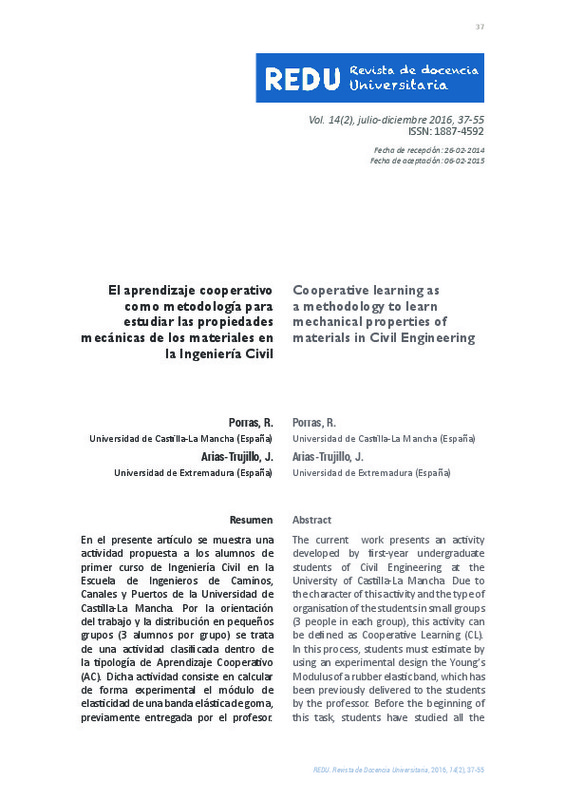|
Resumen:
|
[EN] The current work presents an activity developed by first-year undergraduate students of Civil Engineering at the University of Castilla-La Mancha. Due to the character of this activity and the type of ...[+]
[EN] The current work presents an activity developed by first-year undergraduate students of Civil Engineering at the University of Castilla-La Mancha. Due to the character of this activity and the type of organisation of the students in small groups (3 people in each group), this activity can be defined as Cooperative Learning (CL). In this process, students must estimate by using an experimental design the Young’s Modulus of a rubber elastic band, which has been previously delivered to the students by the professor. Before the beginning of this task, students have studied all the necessary theoretical concepts to develop this experiment, however neither kind of extra indications have been given to them about how to resolve it, so that they should elucidate on their own a testing methodology which allow them to reach the goal of this task. This activity has been carried out for five years, and in spite of its non mandatory character, students have showed a great interest and motivation for it. Paying attention to several criteria such as evaluation, reached objectives or the involvement of the students. The results obtained from the activity have been highly satisfactory both for professors and students.The content of this document is structured as follow: first, the educational context is exposed including the development the subject and the most singular characteristics of the degree. After that, both the curriculum of the subject and the traditional way of teaching Elasticity are exposed. Moreover, it is described the learning strategy proposal and some of the solutions adopted by students. Finally, the most relevant conclusions are drawn.
[-]
[ES] En el presente artículo se muestra una actividad propuesta a los alumnos de primer curso de Ingeniería Civil en la Escuela de Ingenieros de Caminos, Canales y Puertos de la Universidad de Castilla-La Mancha. Por la ...[+]
[ES] En el presente artículo se muestra una actividad propuesta a los alumnos de primer curso de Ingeniería Civil en la Escuela de Ingenieros de Caminos, Canales y Puertos de la Universidad de Castilla-La Mancha. Por la orientación del trabajo y la distribución en pequeños grupos (3 alumnos por grupo) se trata de una actividad clasificada dentro de la tipología de Aprendizaje Cooperativo (AC). Dicha actividad consiste en calcular de forma experimental el módulo de elasticidad de una banda elástica de goma, previamente entregada por el profesor.Los alumnos poseen los conocimientos teóricos necesarios para afrontar dicho experimento, pero no se les ha dado ninguna indicación previa de cómo llevarlo a cabo, así pues deberán dilucidar una metodología de ensayo propia que les lleve hasta la solución del problema. La actividad propuesta, se ha desarrollado durante seis cursos académicos y aunque de carácter voluntario, tiene una gran acogida por parte del alumnado. Los resultados obtenidos atendiendo a criterios como: evaluación, consecución de objetivos, implicación del alumnado, etc. han sido muy satisfactorios.En este documento, en primer lugar se realiza una presentación del contexto educativo en el que queda inmersa la asignatura y algunas de las características más singulares de la titulación. A continuación se presenta el curriculum de la asignatura y se describe la metodología clásica de enseñanza del concepto de elasticidad para, posteriormente, describir la estrategia docente propuesta. Finalmente se muestran algunas de las soluciones adoptadas por los alumnos para realizar la actividad y se presentan las conclusiones más relevantes.
[-]
|








